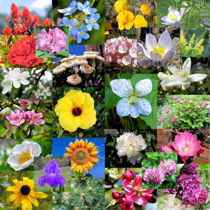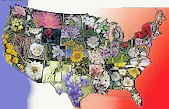
Vermont Symbols
Vermont State Flower
Red Clover

(Trifolium pratense)
Adopted on February 1, 1895.
No. 159 of the Acts of 1894, effective February 1, 1895, designated the Red Clover, (Trifolium pratense,) as Vermont official State Flower.
The red clover represents Vermont's farms and fields. Farmers grow clover as food for cows and other animals. Honeybees gather nectar from the flowers. Some people use red clover to make tea.
Both an integral part of many a cultivated hay field and a common sight along numerous Vermont roadsides, the Red Clover is symbolic of Vermont's scenic countryside generally and of its dairy farms in particular. Oddly enough, however, Trifolium pratense is not a native of Vermont but was "naturalized" from Europe.
Vermont State Flower: Red Clover

Red clover flower plant is a wild growing perennial in meadows throughout Europe and Asia. Red clover is also known as Pavine Clover or Cowgrass.
Red clover flower is small and 15-60 cm. in height. The Red clover flower is a dome-shaped flower cluster. The Red clover flowers are arranged at the terminal shoot. The flower heads are nested in 2-3 leaves. Each red clover flower head is between 1/2 -1 inch wide. Red clover flower has pink to red flower head, made up of many 100-125 or more small typical legume flowers.
Characteristics of the Red Clover
- Longevity: Perennial (acts as Biennial)
- Palatability: High
- Winter Hardiness: Good
- Drought Tolerance: Fair
- Cool or Warm Season: Cool
- Bloat Hazard: Yes
- Use and Comments: Excellent pasture renovation crop, short-term hay crop.
- Distribution in US: Eastern half and Northwest.
- Height: 12-36 inches.
- Leaves: Palmately trifoliolate; leaflets not serrated; inverted V-shaped "water mark" usually present; large stipules; stems leaves and petioles pubescent.
- Inflorescence: Heads consisting of up to 125 flowers; rose purple or deep purplish-red; heads nested in 2-3 leaves.
- Roots: Taproot.
- Soil
- Drainage: Somewhat Poorly Drained
- Fertility: Medium
- pH: 6.2-6.8
- Seed
- Color: Pure yellow tp purple
- Shape: Shortened mit
- Pounds Per Bushel: 60
- Seeds Per Pound: 275,000
- Seeding Rate: 8-10 pounds PLS per acre.
- Emergence Time (Days): 7
- Optimum Germ. Temp. (F): 70
Vermont Secretary of State:
No. 159 of the Acts of 1894, effective February 1, 1895, designated the Red Clover as the official State Flower. Both an integral
part of many a cultivated hay field and a common sight along numerous Vermont roadsides, the Red Clover is symbolic of Vermont's scenic countryside
generally and of its dairy farms in particular. Oddly enough, however, Trifolium pratense is not a native of Vermont but was "naturalized"
from Europe.
------ from Office of the Secretary of State, Vermont Legislative Directory and State Manual,Biennial Session,1993-1994,p.15.
The Vermont Statutes
The law designating the red clover as the official Vermont state flower is found in the Vermont Statutes, Title 1 Chapter 11, Section 498.
Title 1: General Provisions.
Chapter 11: FLAG.
Section 498.
§ 498. State flower
The state flower shall be the red clover.
Taxonomic Hierarchy: Red Clover
Kingdom: Plantae - Plants
Subkingdom: Tracheobionta - Vascular plants
Superdivision: Spermatophyta - Seed plants
Division: Magnoliophyta - Flowering plants
Class: Magnoliopsida - Dicotyledons
Subclass: Rosidae -
Order: Fabales -
Family: Fabaceae - Pea family
Genus: Trifolium L. - clover
Species: Trifolium pratense L. - red clover
State Floral Emblems







